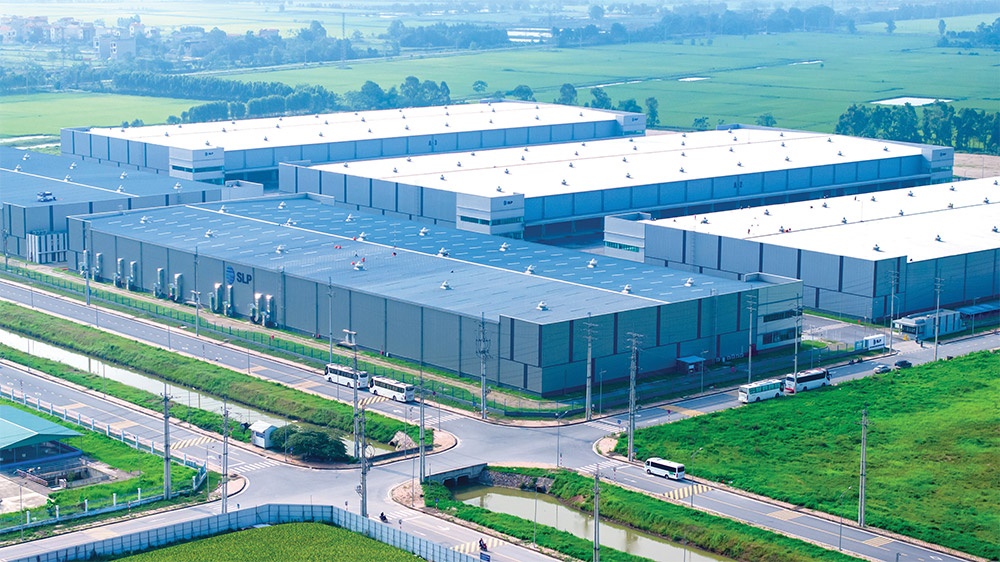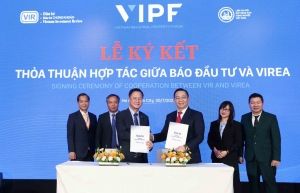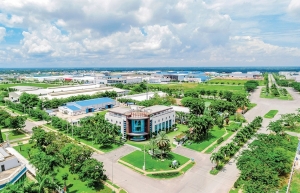What’s in store for green industrial goals
As the world grapples with the pressing challenges of climate change and environmental degradation, the country is making significant strides towards sustainable growth. One of the most promising trends in this journey is the rise of green buildings in industrial parks (IPs). This shift not only aligns with global sustainability goals but also offers a myriad of benefits for businesses and communities alike.
 |
| Do Ngoc Diep, lead for the Green Building and Climate Resilience Programme under the International Finance Corporation in Vietnam |
Traditional IPs, with their high-energy consumption and significant environmental footprint, are increasingly seen as unsustainable. As global awareness of climate change intensifies, there is a growing demand for eco-friendly industrial practices. Vietnam, committed to achieving zero carbon emissions by 2050, is at the forefront of this transformation. The adoption of green buildings in IPs is a crucial step in this direction.
Several factors are propelling the trend of green buildings in Vietnam’s IPs, the first of which is government policy and initiatives. The Vietnamese government has been proactive in promoting sustainable development. Policies such as the National Green Growth Strategy for this decade and the national action plan for the 2030 sustainable development agenda are instrumental in encouraging the development of green IPs. These policies provide a clear framework and incentives for businesses to adopt green practices.
The second factor involves economic incentives. Green IPs are becoming increasingly attractive to investors. These parks offer lower operational costs through efficient resource use and renewable energy integration. Additionally, businesses operating in green IPs can benefit from various tax incentives and subsidies provided by the government.
Thirdly, the adoption of advanced technologies is a key enabler of green buildings. Energy-efficient systems, waste recycling processes, and renewable energy sources are some of the technologies that are being integrated into green IPs. These technologies not only reduce environmental impact but also enhance productivity and competitiveness.
Green industrial growth
Since being introduced to the Vietnamese market over a decade ago, the number of green construction projects has increased rapidly, including industrial buildings. Notably, industrial projects were the first type of construction to receive green building certification in Vietnam, originating from foreign-invested projects in the early 2010s.
We estimate that as of June 2024, the industrial sector leads in the total certified green floor area, with 4.35 million square metres, accounting for 38 per cent of the nationwide green-certified floor space.
In the past five years, specifically during the period from 2018 to 2022, the proportion of green industrial construction floor area accounted for less than 35 per cent of the total certified green floor area. However, considering only the year 2023 and the first half of 2024, the percentage of industrial construction floor area with green certification has consistently exceeded half of the total green certified floor area during the same period.
This clearly reflects the increasing demand for green industrial infrastructure development, aiming to stay ahead of the industry’s shift towards sustainable and environmentally friendly practices.
The transition to green buildings offers numerous benefits. Firstly, green buildings significantly reduce carbon emissions and optimise the use of natural resources. Efficient waste management practices further minimise the environmental footprint of industrial activities.
Secondly, by reducing operational costs and attracting investment, green buildings enhance the economic viability of IPs. The use of advanced technologies and sustainable practices also leads to higher productivity and efficiency.
Thirdly, green buildings provide healthier working environments for employees, with better indoor air quality and natural lighting. This improves worker wellbeing and also boosts morale and productivity.
Fourthly, green buildings are designed to be more resilient to climate change impacts, reducing the risk of damage from extreme weather events. Additionally, adopting green practices helps businesses comply with regulatory requirements and avoid potential fines or penalties.
 |
| The adoption of advanced technologies is a key enabler for green buildings Photo: SLP |
Hurdles and tools
Despite the clear benefits, the transition to green practices is not without challenges. Implementing green technologies and infrastructure requires significant upfront investment.
This can be a barrier for many businesses, particularly small- and medium-sized enterprises.
Some project really aims high with technologies, resulting in high investment cost, however that perception is not popular, as the majority of industrial buildings can go green with almost no additional cost or low additional cost (less than 2 per cent).
Another barrier is technological. Many green technologies are still in the development phase and may not be readily available or affordable. This can hinder the widespread adoption of green practices.
Furthermore, there is a shortage of skilled professionals who can design, implement, and manage green building projects. This gap in expertise can slow down the transition to green practices.
Finally, navigating the regulatory landscape can be complex. There may be a lack of alignment between economic growth policies and climate change initiatives, making it difficult to implement green practices effectively.
In Vietnam, industrial construction projects often choose two popular green certification systems: EDGE or LEED. EDGE, developed specifically for emerging markets, focuses on improving energy and water efficiency as well as reducing carbon emissions in construction. LEED, developed by the US Green Building Council, considers additional factors such as health, amenities, and transportation in industrial projects.
With the support of these tools, industrial constructions – whether factories or warehouses – can easily access and implement green construction practices. Practical solutions include optimising building envelopes, investing in energy-efficient equipment, and using water efficiently to reduce operational costs.
Simultaneously, adherence to technical resource efficiency factors is crucial. Practical and easily integrated elements include reducing solar radiation entering the building through insulated roofs and walls, choosing bright paint colours for increased reflectivity, selecting high-performance lighting fixtures, and minimising water usage through efficient equipment. These solutions are cost-effective and scalable.
The trend of green buildings in Vietnam’s IPs is not just a passing phase but a crucial step towards sustainable development. By embracing green technologies and practices, Vietnam can enhance its industrial competitiveness while contributing to global environmental goals. The journey towards sustainability may be challenging, but the long-term benefits make it a worthwhile endeavour.
 | VIR and Vietnam Industrial Real Estate Association sign deal Vietnam Investment Review, the press agency under the Ministry of Planning and Investment, and the Vietnam Industrial Real Estate Association signed a cooperation agreement at the Vietnam Industrial Property Forum 2024 in Ho Chi Minh City on July 30. |
 | Experts delve into outlook of Vietnam's industrial real estate market at VIPF 2024 At the first panel discussion of the Vietnam Industrial Property Forum (VIPF) 2024, experts discussed the long-term prospects, growth potential, and development trends in Vietnam’s industrial real estate market, and the demand from multinational corporations. |
 | Addressing the barriers to building eco-industrial parks Vietnam, a nation experiencing rapid industrialisation and economic growth, stands at a pivotal point in its developmental trajectory. Rizwan Khan, managing partner, at Acclime Vietnam, looks at the importance of sustainable development and the progress of implementing greener industrial areas. |
 | Incentives can boost eco-IP ambitions Encouraging the development of new models of industrial parks, including eco-industrial parks, is considered one of the most outstanding impacts of Decree No.35/2022/ND-CP on the management of parks and economic zones. |
 | Precise planning vital for relocation of IPs Whether establishing a new industrial park or relocating an existing one, there is a consistent requirement and challenge for stakeholder engagement and comprehensive urban planning. Timothy D. Van Epp, fellow of the American Institute of Certified Planners, and Mai Nguyen of the American Planning Association’s International Division, explain more. |
What the stars mean:
★ Poor ★ ★ Promising ★★★ Good ★★★★ Very good ★★★★★ Exceptional
Related Contents
Latest News
More News
- CEO shares insights on Phu My 3 IP’s journey to green industrial growth (November 17, 2025 | 11:53)
- Business leaders give their views on ESG compliance in industrial parks (November 15, 2025 | 09:00)
- Industrial parks pivot to sustainable models amid rising ESG demands (November 14, 2025 | 11:00)
- Amata plans industrial park in Ho Chi Minh City (November 04, 2025 | 15:49)
- Businesses honoured for building a green future at VIPF 2025 (October 30, 2025 | 13:00)
- Vietnam’s growth formula evolves as high-tech and green industries take lead (October 30, 2025 | 08:34)
- Building Vietnam’s green industrial future: materials, mindset, and resource efficiency (October 29, 2025 | 20:00)
- Vietnam navigates complex landscape to accelerate strategic FDI (October 29, 2025 | 19:00)
- SLP charts strategic path through Vietnam’s industrial real estate market (October 29, 2025 | 18:06)
- VIPF 2025 highlights Vietnam’s evolving real estate landscape (October 29, 2025 | 18:03)

 Tag:
Tag:





















 Mobile Version
Mobile Version